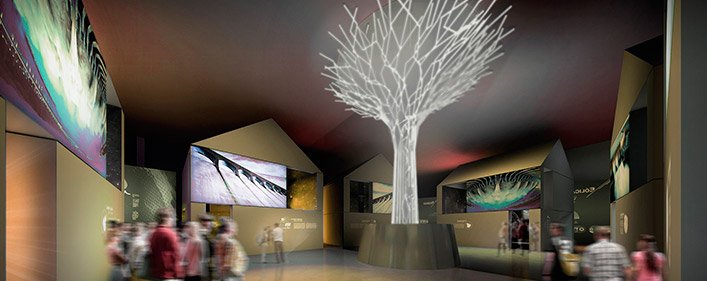- The Spanish Pavilion will have a total surface of 868 m2 presenting the past, present and future of Spain’s exploitation of its natural resources, in addition to the need to treat the planet and its energy sources in a responsible and sustainable manner.
-
The design and execution of the Pavilion will include several types of audio-visual productions: immersive, sensorial and synchronised.
-
ACCIONA Producciones y Diseño will also be responsible for the exhibition content of the first and second floors of the National Pavilion of Kazakhstan – the country hosting the International Exposition -.

Acción Cultural Española (AC/E) – the public agency responsible for managing Spain’s presence at World and International Expos – has chosen ACCIONA Producciones y Diseño (APD) and Frade Arquitectos to design and execute the pavilion that will represent Spain at the 2017 Astana International Expo (Kazakhstan).
ACCIONA Producciones y Diseño will also design the exhibition content of two floors of the National Pavilion of Kazakstan which, as the hosting nation, will be focal point of the Expo.
Spain’s Pavilion: “Energy for the Planet”
The Spanish Pavilion, as part of the 2017 Astana Expo theme “Energy for the future”, has defined its own leitmotiv as “Spain, Energy for the Planet” and the contents of the pavilion will focus on transmitting the relevance of the climate change problem and the initiatives to tackle it that are being carried out in our country.
The Spanish Pavilion will have a total surface of 868 m2, distributed on one single 8m-high floor, and will present the past, present and future of Spain’s exploitation of its natural resources, in addition to the need to treat the planet and its energy sources in a responsible and sustainable manner.
The central area of the pavilion will be designed as a large square or forum and arranged around it will be a series of houses of different historical periods in Spain, a metaphorical representation of the “global village”.
Visitors to the Spanish Pavilion will embark on a journey to discover the great global village we all belong to, from the perspective of the exploitation of natural resources, and the country’s concern, determination and efforts to, once more, treat the planet and its energy sources in a sustainably responsible manner.
The Spanish Pavilion is located in cluster C1, in the northern section of the Expo site next to Germany, Monaco and the Netherlands.
National Pavilion of Kazakhstan
ACCIONA Producciones y Diseño has also been chosen to develop and implement the exhibition content for the first and second floors of the National Pavilion of Kazakhstan, designed as an eight-level sphere. Each level is dedicated to a type of energy: hydraulic, space, solar and wind, biomass and kinetic. The top level will inform visitors about the future of Astana –Kazakhstan capital in 2050-.
APD will execute the 2400m2 exhibition area on the base of the “Sphere”, the National Pavilion, and the 800m2 second level, dedicated to hydraulic energy.
The National Pavilion of Kazakhstan – nation hosting the Expo – will be the focal point of the Exposition and will hold the permanent Museum of Energy.
2017 Astana Expo
The 2017 Astana International Exposition, with the theme Energy for the future, expects to bring together, between the 10th of June and the 10th of September, 130 official participants: 112 Nations and 18 International Organisations, and attract more than 3 million visitors.
Around ten energy-related international organisations will take part in this International Exposition, such as the International Renewable Energy Agency (IRENA), the United Nations’ Industrial Development Organization (UNIDO) or the World Bank.
The Expo commemorates the 20th anniversary of the election of Astana as the new capital (the word means capital in Kazakh) at the expense of Almaty. Located in the centre of the country, the city has grown from its 200.000 inhabitants in 1997 to more than 850.000 today. After the Expo, it is expected that the site will host the largest financial centre in Central Asia together with the International Centre for the Development of Green Technologies under the auspices of the UN.